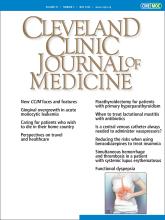Table of Contents
From the Editor
- New CCJM faces and features
Hospitalist James Pile, MD, and nephrologist George Thomas, MD, join the Journal staff as deputy editors.
The Clinical Picture
- Gingival overgrowth in acute monocytic leukemia
A 55-year-old man presented to the emergency department with a 2-month history of progressive gingival swelling and oral pain.
Editorial
- Perspectives on travel and healthcare
Further guidelines are needed to address the challenges faced by patients traveling to receive medical care away from their home country or returning to their home country to die.
1-Minute Consult
- Should I refer my patient for a parathyroidectomy?
In patients with primary hyperparathyroidism, this decision should be individualized and not based solely on whether guideline criteria are met.
- Does every patient with lactational mastitis require antibiotic treatment?
Not all do. Depending on the duration and severity of symptoms, some patients can be managed conservatively.
- Do I always need a central venous catheter to administer vasopressors?
Although generally preferred, central venous catheters carry risks such as procedural complications, infection, and thrombosis. Clinicians must assess, case by case, whether a peripheral intravenous catheter can be used.
Current Drug Therapy
- Reducing the risks when using benzodiazepines to treat insomnia: A public health approach
The authors review measures for preventing harm before benzodiazepines are prescribed, decreasing harm within 4 weeks after they are prescribed, and limiting harmful effects of long-term prescribing.
Review
- Functional dyspepsia: How to manage the burn and the bloat
The authors discuss how to diagnose and treat the 2 subtypes of functional dyspepsia: epigastric pain syndrome (burning and pain) and postprandial distress syndrome (bloating and satiety).
Symptoms to Diagnosis
- Simultaneous hemorrhage and venous thrombosis in a patient with systemic lupus erythematosus
After undergoing hip arthroplasty, the patient had hematoma formation in the pelvis, active bleeding from the surgical site, and a prolonged activated partial thromboplastin time. Careful evaluation led to the diagnosis of an acquired bleeding disorder.





Commentary
The authors offer a framework for providing equitable care to terminally ill patients who seek the comfort of dying at home.